Psittacula longicauda (Boddaert, 1783)
Table of Contents
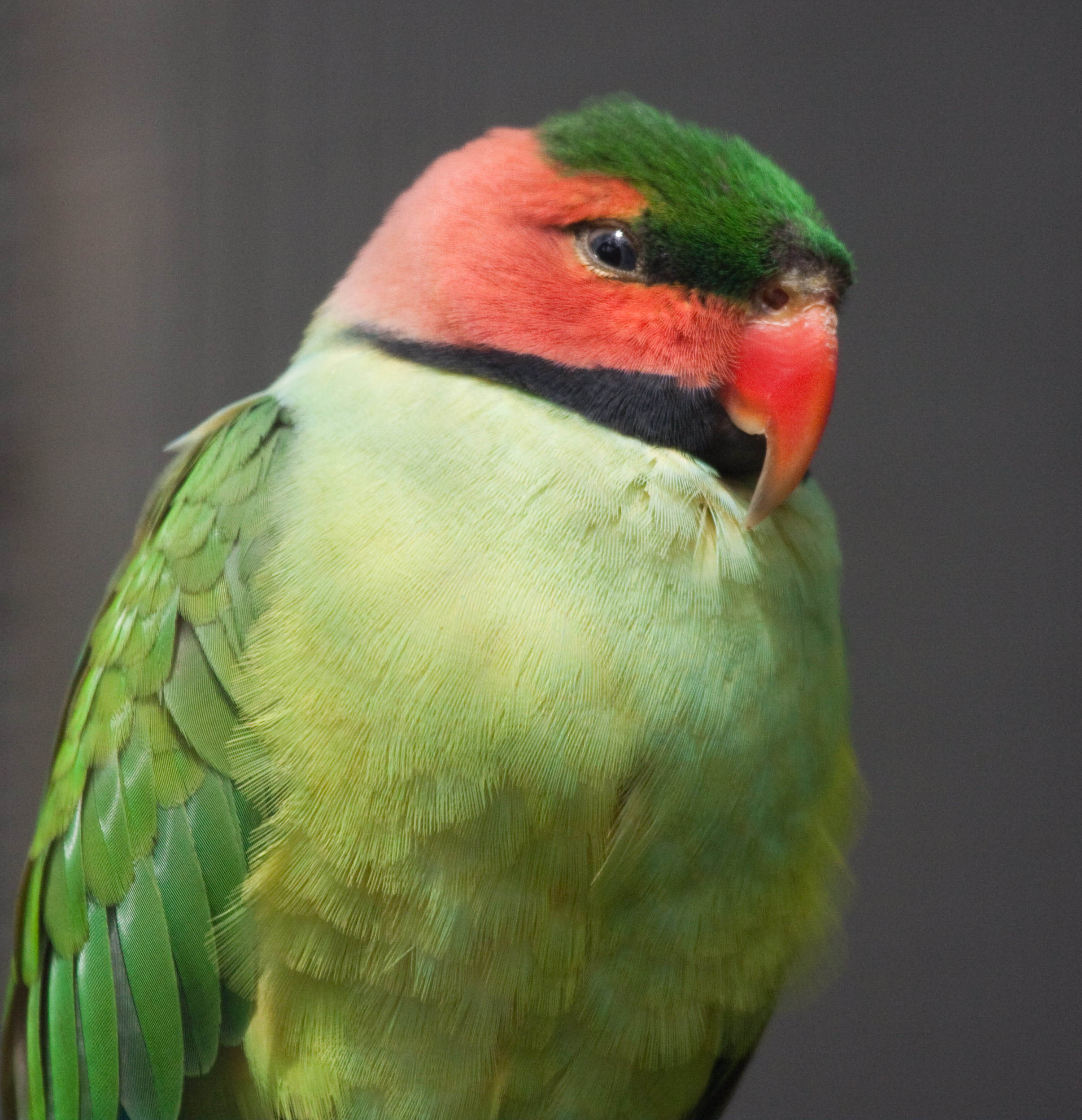
Figure 1: Close up of long-tailed parakeet. Photo by Nathan Rupert, taken on 24th April 2011, in Western San Diego, California.
Brief Summary
Commonly known in English as the long-tailed parakeet, the scientific name of this bird is Psittacula longicauda. It is native to Singapore and may be found in other countries around the world. The bird may be recognised by its sharp distinct screeching flight call and colouration of red cheeks, beak and long blue tail. Due to illegal capture for the bird trade and destruction of its habitats, its conservation status is listed as Near-Threatened under the IUCN Red List.In Singapore
Psittacula longicauda is native to Singapore and may potentially be displaced by more exotic species such as the red-breasted parakeet (Psittacula alexandri) (Neo, 2012).The long-tailed parakeet may be found in old secondary forest, young secondary forest and plantations in Singapore (Castelletta et al., 2005). While the locations where the birds were sighted are not specifically listed, some of the sites surveyed for old secondary forest are Macritchie Forest, Botanic Garden Forest; Mount Faber Park and Kent Ridge Park for young secondary forest; Yishun Park and Loyang Park for plantations (Castelletta et al., 2005).
Based on a 2015 parrot count survey, the long-tailed parakeet has numerous roosting sites in Yishun (among urban trees), which highlights the importance of urban greenery for this species, given its Near-Threatened global conservation status, since its roosting sites are in urban greenery at least in northern Singapore (Low & OwYong, 2015). The 2015 survey determined that large flocks of this species travel along the eastern boundary of the Central Nature Reserve to the roosting sites in Yishun, stopping at resting sites in Springleaf (Low & OwYong, 2015).
For the past 3 available records for the Annual Parrot Counts, the long-tailed parakeet was the most numerous parrot recorded in the 2015, 2016 and 2017 surveys (Low & OwYong, 2015; Low & OwYong 2016; Low & OwYong, 2017).
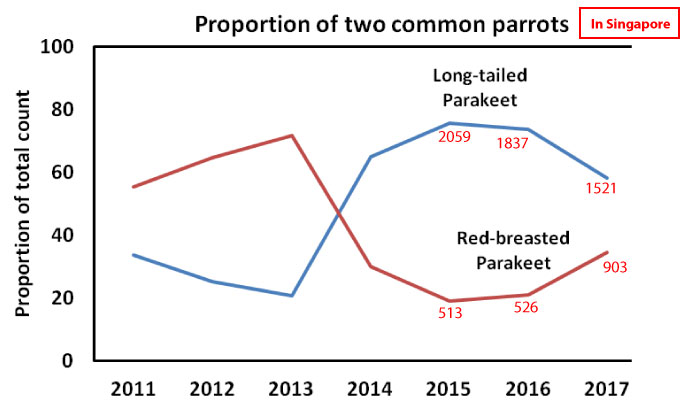 |
| Figure 2: Proportion of long-tailed parakeets compared to red-breasted parakeets based on parrot counts in Singapore from 2011-2017. Available numbers for the parakeets from the 2015, 2016 and 2017 surveys are labeled, showing the decreasing count of the long-tailed parakeet and the increasing count of the long-tailed parakeet. Low & OwYong (2017) believe that instead of a genuine decline in numbers of the long-tailed parakeet, it could be possible that the decline and increase in numbers of these 2 species could be attributed to changes in foraging and roosting habits, since there were increases in numbers of long-tailed parakeets spotted in Bottle Tree Park. Click here for a visual comparison between the long-tailed parakeet and the red-breasted parakeet. Figure adapted from the 7th parrot count report. |
The long-tailed parakeet has been spotted in Bottle Tree Park, Yishun Street 11, Springleaf Park Sites A and B, Windsor Park, Mount Rosie, Dakota Crescent, Bukit Brown, Lower Peirce and King Albert Park (Low & OwYong, 2015; Low & OwYong, 2017). Read the full parrot count reports here.
Some other locations in which the long-tailed parakeet has also been spotted include: Botanic Gardens, Neo Tiew Lane 2, Admiralty Park (Singapore Birds, 2017), Kranji Marsh, Changi (HBW Alive, 2017), and National University of Singapore (The Birds of NUS, 2012).
The long-tailed parakeet is a parrot regulated by CITES and Agri-Food & Veterinary Authority of Singapore requires proper permits before its import into and export out of Singapore (Agri-Food & Veterinary Authority of Singapore, 2017). Singapore is a major transit hub for international bird trade, the species most affected is the African Gray (Psittacus erithacus), and there is a huge discrepancy in the import-export records of birds (National Geographic, 2016). Whether the long-tailed parakeet is one of the birds in Singapore's bird trade is unknown. It does not seem to be available in local pet bird shops (pers. obs. ), but there is one record of a juvenile long-tailed parakeet being sold online in Singapore. As it is native to Singapore, it may be possible that it is captured for sale within Singapore, but the decrease in number counts of the 2015-2017 surveys does not seem large enough that it makes the decrease attributable to capture.
While it is unclear whether it is part of the bird trade in Singapore, the species is sold in Indonesia online and in bird markets (Sheperd, 2006; Iqbal, 2015). Click here to read about the Near-Threatened status designated by IUCN.
Description
Colouration
Colouration notes and description in the captions are obtained from Parrots: A Guide to Parrots of the World by Parr and Juniper (2010).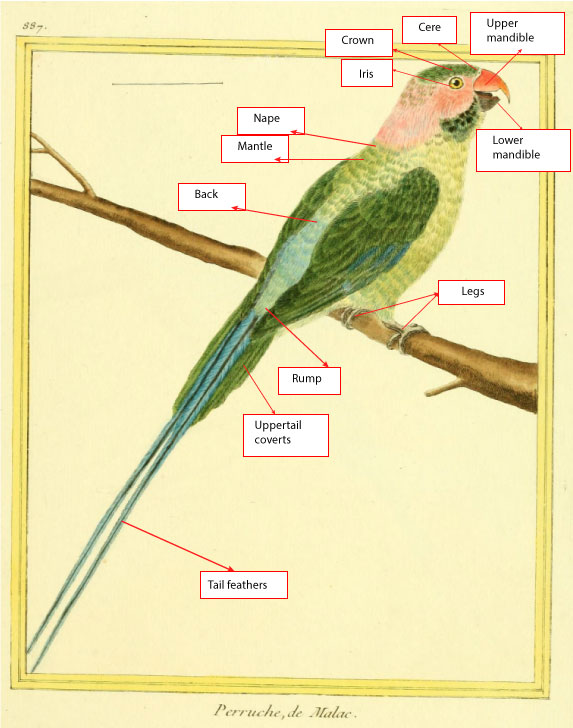 |
Figure 3: A labeled diagram of the long-tailed parakeet, adapted from the original illustration by Boddaert (1783). Psittacula longicauda has overall green plumage and a dark green crown The nape and mantle are a pale grey-green and fades to a bright blue back. The iris is yellow and the legs are grey. The upper mandible is red while the lower mandible is brown. The cere is pale grey. The rump and uppertail coverts are green. The central tail feathers are blue with yellow tips; outer tail feathers are green. |
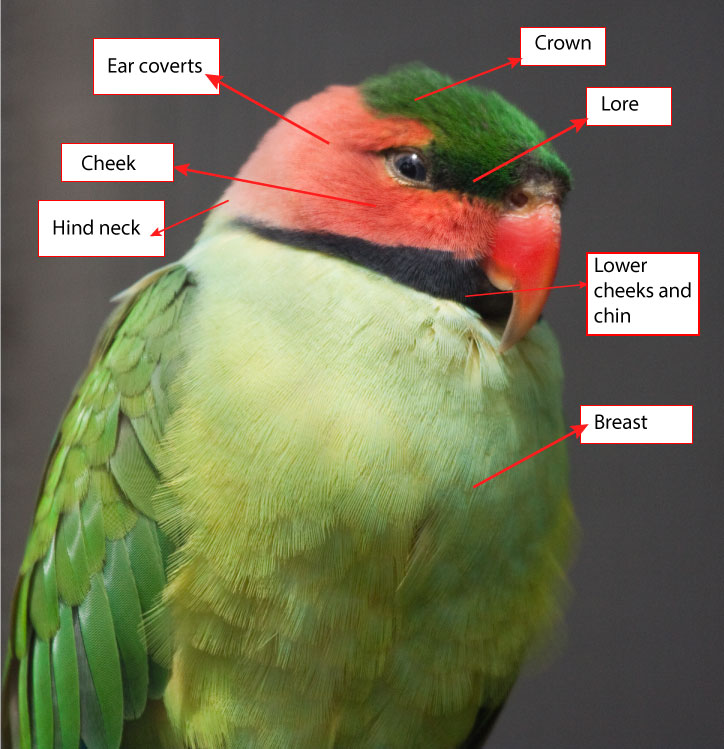 |
Figure 4: The cheeks, ear-coverts and hindneck are a bright salmon-pink to red colour. The lower cheeks and chin are black in colour. The lores (feathers between the nostrils and the eyes) are blackish-green. The dark green crown is also visible here. Diagram adapted from photo by Nathan Rupert, taken on 24th April 2011, in Western San Diego, California. |
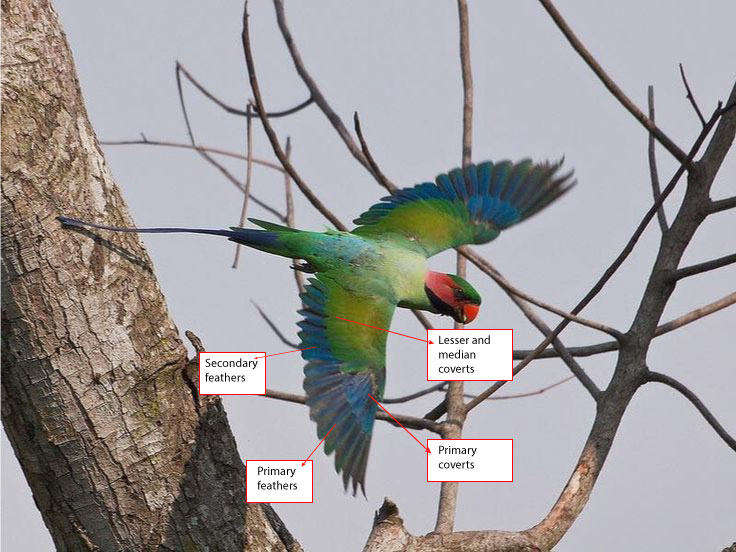 |
Figure 5: Long-tailed parakeet in flight, displaying the blue primary feathers, blue primary coverts (feathers that cover other feathers) and blue secondary wing feathers. The lesser and median coverts are dark green-black. The long blue central tail feathers are also visible here. The underwing coverts (coverts on the underside of the wing) are yellowish (not visible in this photo). Click here for a complete diagram of wing feathers. Diagram adapted from photo taken by Chong BT, in Kuala Langat, Malaysia, 2012. |
To distinguish it from other species, click here.
Click here to view an adult specimen.
Sound
The species may generally be located by its racuous cries made from the canopy (Parr & Juniper, 2010).It has a wide variety of loud screeches and cries: a high-pitched peeyo-peeyo-peeyo, a goose-like graak-graak-graak, and a scolding cheet-cheet-cheet sound made in bursts (Parr & Juniper, 2010).
| Audio 1: Call of the long-tailed parakeet (with house crow sounds in the background). Audio recorded by Yong Ding Li in the Central Catchment Nature Reserve, Singapore, on the 14th January 2014. If the audio player does not appear, click here. Available for use under Creative Commons Attribution-NonCommercial-ShareAlike 3.0. |
| Audio 2: Flight call of the long-tailed parakeet. Audio recorded by Eric Cannizzaro (Bornean Bird Conservation) in the Planted Forests Zone, Wildlife Buffer, Sarawak, Malaysia, on the 25th March 2011. If the audio player does not appear, click here. Available for use under Creative Commons Attribution-NonCommercial-ShareAlike 3.0. |
Its voice is similar to the Ring-necked Parakeet (rose-ringed parakeet, Psittacula krameri), which is also present in Singapore (Parr & Juniper, 2010). Listen to Audio 3 to hear how the Ring-necked parakeet sounds like.
| Audio 3: Call of the rose-ringed parakeet. Audio recorded by Robson Silva e Silva in Begraafplaats, Leiden, Holland, on the 29th December 2014. If the audio player does not appear, click here. Available for use under Creative Commons Attribution-NonCommercial-ShareAlike 3.0. |
General Measurements
Psittacula longicauda may weigh between 170 - 200 grams and measure between 40 - 50 cm (Faheem, 2017).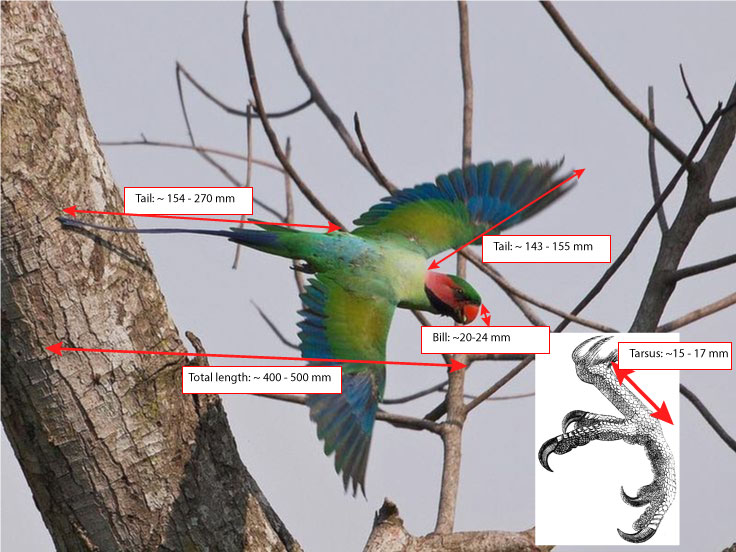 |
| Figure 6: General measurements of the long-tailed parakeet (Parr & Juniper, 2010). The tail length is shorter in females resulting in shorter total length for females. Diagram adapted from photo taken by Chong BT, in Kuala Langat, Malaysia, 2012 and photo from Amazing Parrot Feet. |
Sexing
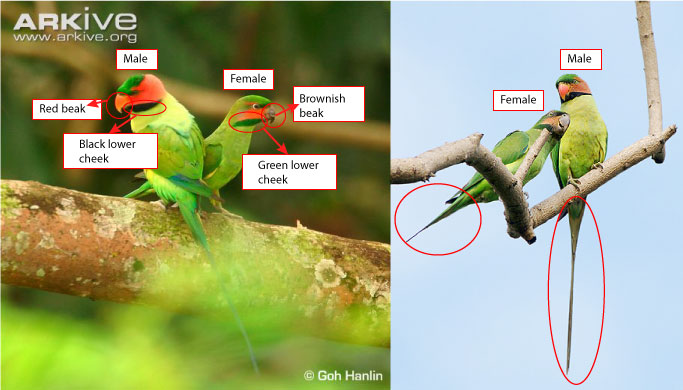 |
| Figure 7: The female of the species can be distinguished from the male by a shorter tail, brownish beak, and dark-green cheek patches (Parr & Juniper, 2010). Diagram adapted from photo by Goh Hanlin and Nick Baker . |
Juvenile
The juvenile of the species is also largely green, but with brown-pink upper cheeks and dark patches on lower cheeks and chin (Parr & Juniper, 2010).Young males will show a bluish patch on the lower back and reddish upper mandible (Parr & Juniper, 2010).
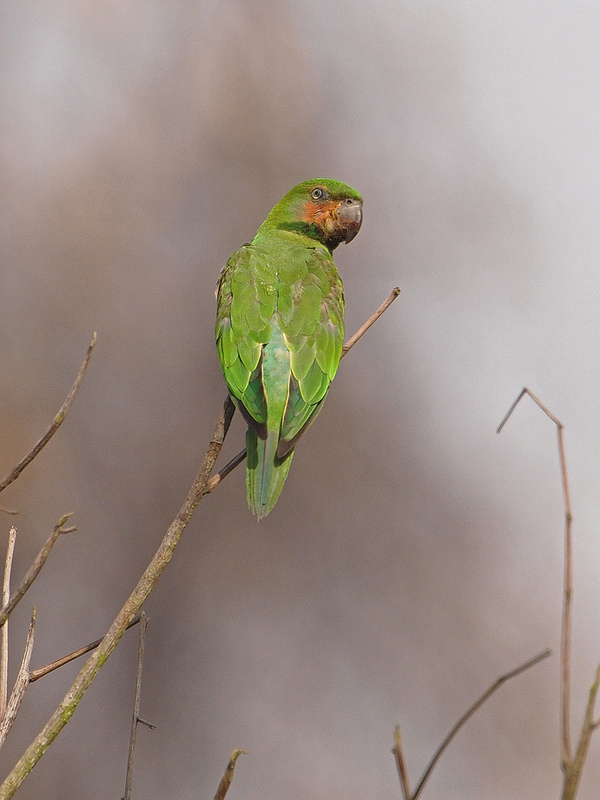 |
Figure 8: Juvenile long-tailed parakeet. The tail is short relative to the overall body length. Photo by Chong BT, taken in Kuala Langat, Malaysia, 2012. |
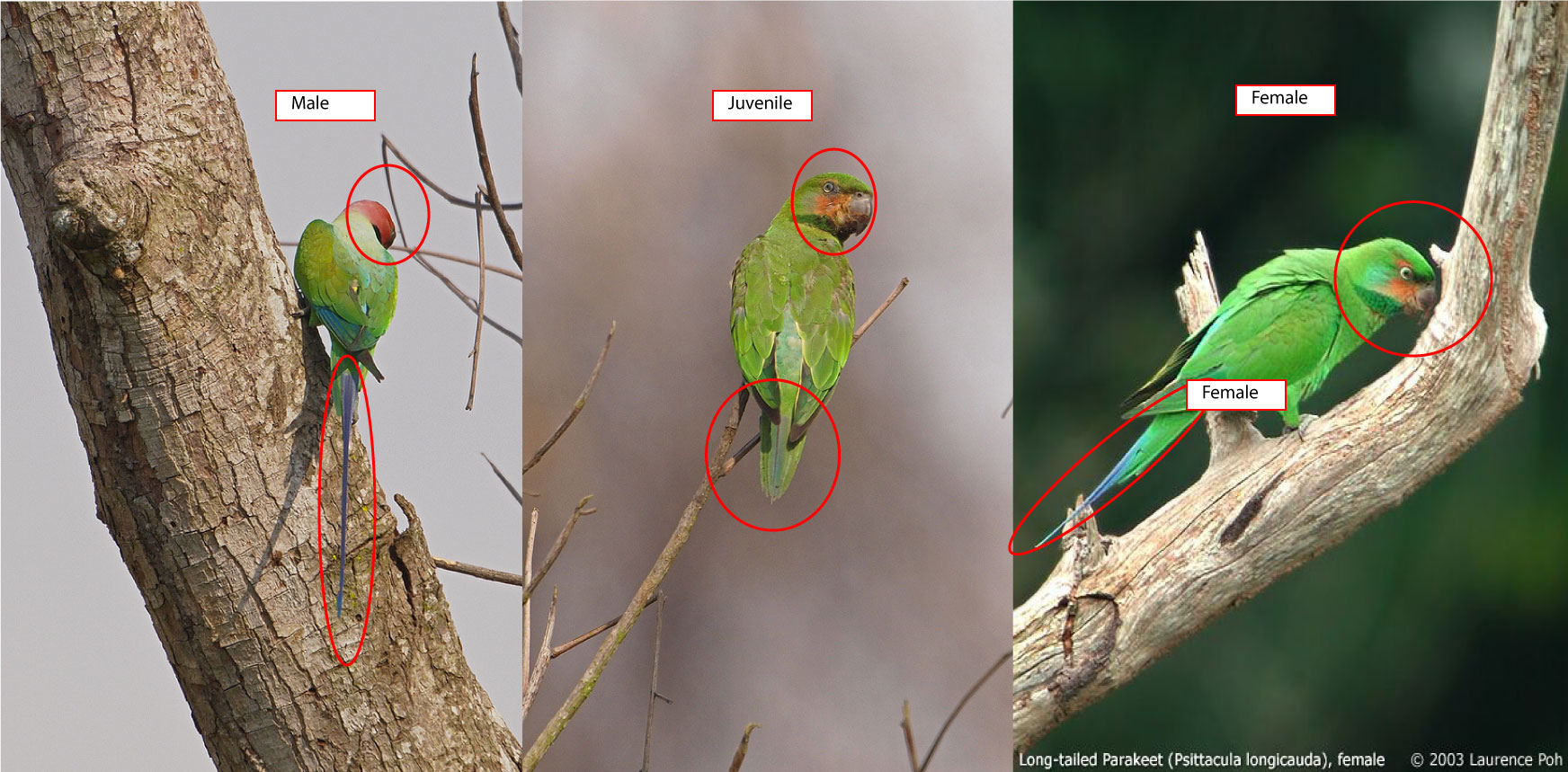 |
| Figure 9: Comparison of the juvenile with the female and male adults of the species. The tail is much shorter and the colouration of the cheek tends toward brown-pink and is less vibrant. The cheek colouring may be similar to the female adult but may be distinguished by the female adult having a longer tail with blue feathers. Diagram adapted from photos taken by Chong BT, in Kuala Langat, Malaysia, 2012 (left and centre images); and Laurence Poh (right image). |
Biology
Behaviour
The species may generally be found in small, noisy flocks that fly fast with great agility (Parr & Juniper, 2010).The species lives in social groups; with flocks numbering in the thousands seen in Andamans and Borneo, but smaller flocks of less than 20 may be more typical, especially during breeding seasons (Parr & Juniper, 2010).
Feeding Habits
Psittacula longicauda feeds on fruits and was counted at a higher number in Macritchie than Nee Soon in a single study, possibly due to there being more fruiting trees in Macritchie than in Nee Soon (Sodhi, 2002).
Psittacula longicauda may feed on camphor tree and elephant apple fruit, orchard and plantation fruit (for example, oil palm Elaeis), grain, seeds, ripening rice in the Andaman Islands, and oil palm fruit in the Malay Peninsula (Parr & Juniper, 2010).
| Video 1: Footage of male and female long-tailed parakeets eating, with the male on the left and female on the right. Video taken in Singapore, exact location not stated by video author. If the video does not appear, click here. |
| Video 2: Footage of long-tailed parakeet feeding on starfruit in Macritchie, Singapore. If the video does not appear, click here. |
| Video 3: Footage of long-tailed parakeet eating female flowers of Alexandra Palm in Singapore, location not stated by video author. If the video does not appear, click here. |
Reproduction
Psittacula longicauda may typically nest high up in cavities of dead trees, with clutches of 2 - 3 eggs laid on decaying wood and bark (Parr & Juniper, 2010). Nesting heights have been reported at 4m, 10m and 45m (Parr & Juniper, 2010). The species breeds in colonies; eggs are laid between December to February and the nestlings appear in July (Parr & Juniper, 2010).| Video 4: A pair of long-tailed parakeets copulating in Neo Tiew Lane 2, Singapore. If the video does not appear, click here. |
Conservation Status
Psittacula longicauda is recorded as Near-Threatened in the IUCN Red List, as of the latest update in 2016 (last accessed 2nd December 2017). |
| Figure 10: The species conservation status is in the Near Threatened category, according to the IUCN Red List. Image is a screenshot taken from the IUCN Red List (accessed 2nd December 2017). |
The current population of Psittacula longicauda is decreasing globally, due to the following major threats: forest loss in the Sundaic lowlands, hunting and bird trade (Birdlife International, 2016). Forest loss in the Sundaic lowlands is progressing at a fast rate due to logging, land conversion, obtaining valuable timber including those inside protected areas, and forest fires (especially in the period 1997 - 1998). Hunting of the species occurs when locals in south Sumatra hunt the bird for trade or treat it as a pest (Birdlife International, 2016). Psittacula longicauda may also be found in local markets or sold online (Iqbal, 2015) as part of the bird trade (Birdlife International, 2016).
The IUCN justifies the Near Threatened conservation status due to the forest destruction in these locations: Sundaic lowlands of Indonesia, Thailand and Malaysia. The destruction is vast in Thailand and Malaysia - Kalimantan has lost almost 25% of evergreen forest from 1985 - 1997; Sumatra has lost almost 30% of its 1985 forest cover (Birdlife International, 2016). However, due to the ability of Psittacula longicauda to forage in locations away from forested areas, the decline in population numbers are estimated to be 20 - 30% in the past 10 years (Birdlife International, 2016).
According to the IUCN, conservation actions are underway and the CITES Appendix II is part of the conservation actions proposed. Other conservation actions proposed include: monitoring the species in trade, monitoring habitat trends and deforestation rates in the Sundaic lowlands via the use of satellite images and remote sensing capabilities, researching ecology of Psittacula longicauda to better understand its nomadic movements, effectively protect large areas of suitable habitat at key sites in which the species resides in both protected and multiple use areas (Birdlife International, 2016).
The long-tailed parakeet is one of the species being affected by the illegal bird trade in Medan, north Sumatra, both for local demand in Indonesia and for overseas exports (Shepherd, 2006).
As Pets
The long-tailed parakeet was on sale for USD17 on Indonesia's online market (Iqbal, 2015), and a juvenile on sale for 140SGD in an online Singapore listing.There is no information on the care of this species as pets - it could be that since this species is sold in Indonesia (Sheperd, 2006, Iqbal, 2015) and Thailand (Chng & Eaton, 2016) most of the information is in another language.
Distribution
Psittacula longicauda is native to the following countries: Brunei Darussalam; India; Indonesia; Malaysia; Myanmar; Singapore and Thailand (BirdLife International, 2016).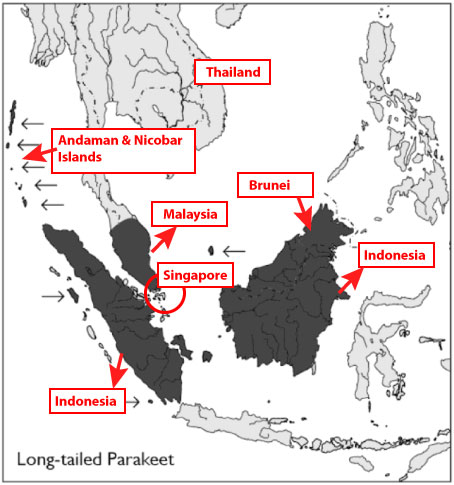 |
| Figure 11: Psittacula longicauda may be found in the Andaman and Nicobar islands, India, Coco islands, Myanmar, peninsular Thailand, Sabah, Sarawak and Peninsular Malaysia, in Singapore, Kalimantan (including the Natuna Islands), in Sumatra (including the Riau Islands), Indonesia and is widespread in Brunei (BirdLife International, 2016). Distribution of Psittacula longicauda, as depicted by the dark shaded areas (which may not accurately represent their distribution, since they may also be found in Thailand). A few key areas, including Singapore, are labeled to show where this map represents. Diagram is adapted from Parrots: A Guide to Parrots of the World. |
Habitats
Psittacula longicauda may be found in all types of lowland (typified as below 300m in Sumatra), evergreen forest in mangroves, swamp-forest, rainforest, oil-palm (Elaeis) plantations and coconut groves (Parr & Juniper, 2010). The species may show a preference for high forest edges with large dead trees, including the proximity of cultivated areas (Parr & Juniper, 2010). It is unknown why they have a preference for such habitats, but it could be due to the presence of food in cultivated areas.In Nicobar, the species has been spotted visiting parks and gardens (Parr & Juniper, 2010).
While there are pictures of the long-tailed parakeet available, it is not stated what these habitats are. Click here to view additional pictures.
Taxonomy
Name
Binomial: Psittacula longicauda (Boddaert, 1783)Common (English): Long-tailed parakeet
Etymology
The species epithet longicauda is derived from the Latin words longus and cauda, meaning long and tail respectively (Brown, 1956).Synonyms
Psittacus longicauda Boddaert, 1783The long-tailed parakeet was first named by Boddaert in 1783 and a reclassification of the genus (Psittacus to Psittacula) was done in the same year, possibly due to classification error on Boddaert's part. The genus Psittacus contains the African Gray parrot and the Timneh parrot, both of which look very different to the long-tailed parakeet, and the reclassification would most likely be based on morphology comparison to the African Gray parrot (the Timneh parrot was not yet described at 1783) as molecular systematics for phylogeny was not developed till the 1960s (Suárez-Díaz & Anaya-Muñoz, 2008).
Taxonomic Hierarchy
| Kingdom |
Animalia |
| Subkingdom |
Bilateria |
| Infrakingdom |
Deuterostomia |
| Phylum |
Chordata |
| Subphylum |
Vertebrata |
| Infraphylum |
Gnathostomata |
| Superclass |
Tetrapoda |
| Class |
Aves |
| Order |
Psittaciformes |
| Family |
Psittacidae |
| Subfamily |
Psittacinae |
| Genus |
Psittacula Cuvier, 1800 |
| Species |
Psittacula longicauda (Boddaert, 1873) |
Subspecies
Psittacula longicauda currently has 5 recognised subspecies.Psittacula longicauda defontainei Chasen, 1935
Psittacula longicauda longicauda (Boddaert, 1783)
Psittacula longicauda modesta (Fraser, 1845)
Psittacula longicauda nicobarica (Gould, 1857)
Psittacula longicauda tytleri (Hume, 1874)
Taxonomic Hierarchy and Subspecies information from: Integrated Taxonomic Information System (ITIS)
Phylogeny
As the genus Psittacula had evolutionary relationships that have not been conclusively resolved, and prior taxonomic judgements were made only on morphological characters (the 3 head plumage (feather) patterns: black neck ring, head feather colouration and 'moustache' neck plumage pattern), Groombridge et al. (2004) reconstructed a phylogeny of the of Psittacula parakeets based on roughly 800 base pairs of mitochondrial cytochrome b sequence. Their phylogeny was created using maximum parsimony, distance (neighbour-joining) and maximum likelihood methods of phylogeny reconstruction (Groombridge et al., 2004). Their phylogenetic trees for all 3 methods displayed 3 distinct groups (Figure 12) within the genus, which corresponds to the 3 distinct head plumage patterns that these 3 groups have (Figure 13).
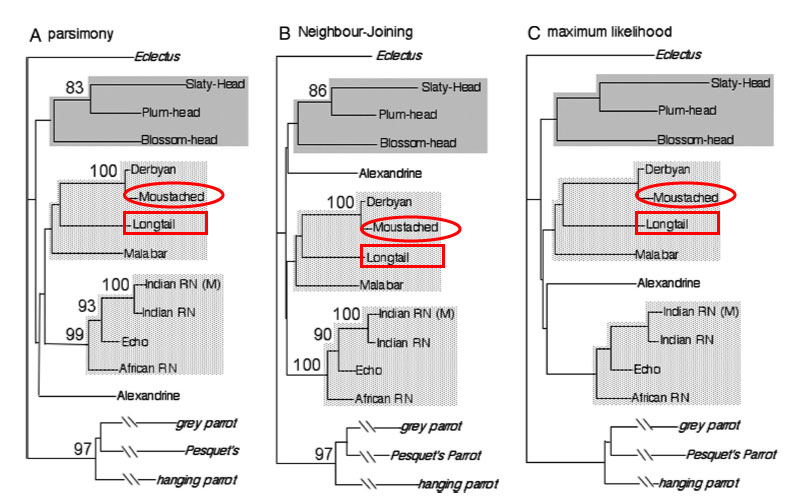 |
| Figure 12: Phylograms produced by different phylogenetic methods: (A) maximum parsimony; (B) neighbour-joining; and (C) maximum likelihood (molecular clock). Bootstrap values of >70% are shown. The long-tailed parakeet is denoted with the red rectangles. The moustached parakeet (labeled with ellipses) refers to the red-breasted parakeet, the introduced non-native in Singapore mentioned above. The grey parrot, Pesquets parrot, and the hanging parrot were the outgroups (reference groups) used in this study and the long branch lengths have been truncated in this diagram. (Diagram adapted from Groombridge et al. 2004). |
While the placement of the 3 distinct groups (shaded in Figure 12) were consistent in all three phylogenetic methods, bootstrap values of these 3 groups were not strong (defined as <70%). Additionally, the placement of the Alexandrine parakeet in each tree varied. Groombridge et al. (2004) think that these anomalies could be due to 2 reasons: (1) phylogenetic information could have been lost due to shorter internal branch lengths relative to long terminal branches, and (2) there was insufficient representation of the Psittacula parakeets due to unavailability of samples owing to recent extinctions in the genus.
The bootstrap values for the Moustached parakeet and the Derbyan parakeet is 100% for the maximum parsimony and neighbour-joining method and is also consistently placed in the maximum likelihood tree, showing complete support that the Derbyan and Moustached parakeet species are sister to each other. However, it is not certain that the long-tailed parakeet is sister to the moustached-Derbyan parakeet group, since the bootstrap values are less than 70%. As such, it can only be said that the long-tailed parakeet may be closely related to the Derbyan and moustached parakeet, as there is consistent placement in the phylogenies for the 3 phylogenetic methods, but it is not certain.
Their study also mapped the maximum likelihood tree to the head plumage characters of the species. The topology test by Shimodaira and Hasegawa (1999) was used to compare likelihood scores of the phylogenetic methods determined that the maximum likelihood tree best-fitted the sequence data as compared to the neighbour-joining and maximum parsimony methods (Groombridge et al., 2004), hence the maximum likelihood tree was considered more accurate and used for the mapping of plumage characters.
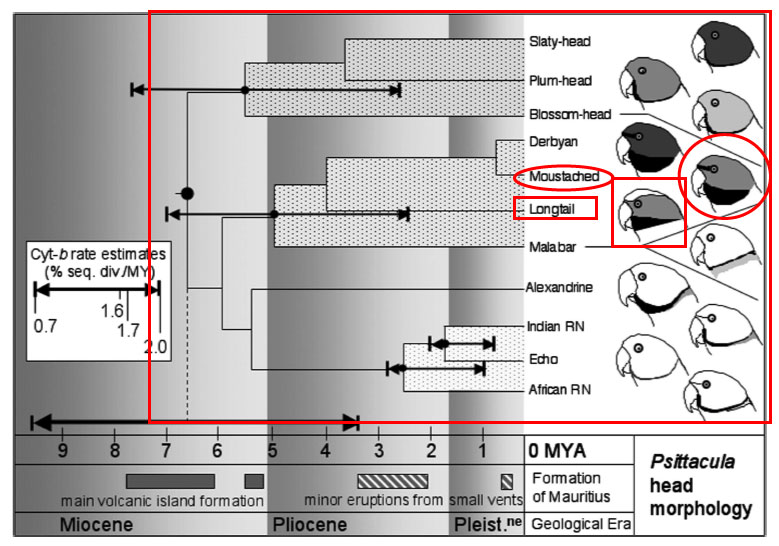 |
| Figure 13: The maximum likelihood tree was aligned to the head plumage characters of the parakeets (outgroups not shown for illustrative purposes). This diagram shows that the head plumage characters correspond to the phylogeny constructed by Groombridge et al. (2004) (species closer to each other on the maximum likelihood tree have more similar head plumage characters). It also shows that the red-breasted (moustached) parakeet is placed close to the long-tailed parakeet on the tree and both have similar head plumage. (Diagram adapted from Groombridge et al., 2004). |
While Figure 13 above shows how morphological characteristics may be somewhat accurate in determining the relatedness of Psittacula species, their study also determined that this may not always be the case (see Figure 14 below).
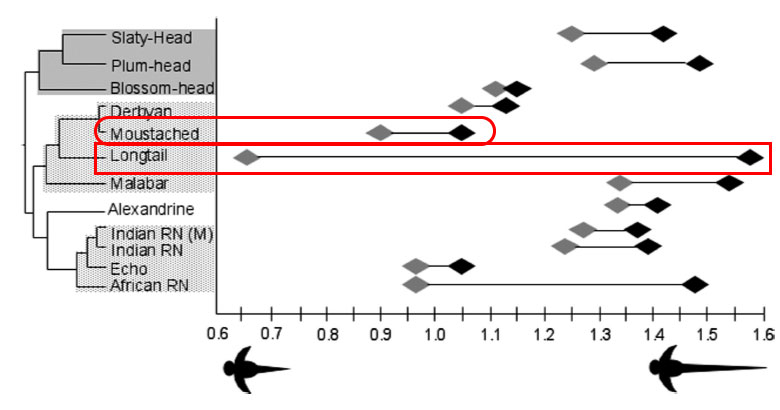 |
| Figure 14: The maximum likelihood tree was also mapped against the wing to tail ratios of the various parakeet species. The diagram shows that there is no correlation between the wing:tail ratios of each species and how closely they are placed on the tree (species closer to each other on the maximum likelihood tree do not have similar wing-tail ratios), therefore wing:tail ratios cannot be used as a morphological character to accurately determine relatedness between species. The dark-shaded diamonds represent the wing:tail ratios for the males and the light-shaded diamonds represent the wing:tail ratios for the females; the line between the diamonds represent the extent of sexual dimorphism between the male and the female with respect to wing:tail ratio. The extent of sexual dimorphism for wing:tail ratio is lower in the red-breasted (moustached) parakeet compared to the long-tailed parakeet (less of a difference between the male and female for the red-breasted compared to the long-tailed parakeet). (Diagram adapted from Groombridge et al., 2004). |
The results of the study by Groombridge et al. (2004) provides an insight into the phylogeny of the Psittacula genus based on molecular data (mitochondrial cytochrome b sequence), which had never been done, and previous relationships (unavailable) were determined only based on morphological data. Given that their study made use of molecular data for the phylogeny reconstruction, it is relatively more accurate than the ones based on morphological data (also shown by Figure 14), and may provide a basis for more accurate phylogenies in future.
Diagnosis
This section will explain how to distinguish between species based on morphological characteristics.Psittacula longicauda may be differentiated from its congeners Blythe's Parakeet (Nicobar islands), Red-breasted and Alexandrine Parakeets in Andaman islands and the feral Ring-necked Parakeet (rose-ringed parakeet) in Singapore by a combination of the following distinguishing characteristics: red cheeks, green crown, pale grey-green nape and mantle, and long blue central tail (Parr & Juniper, 2010).
The red-breasted parakeet, Alexandrine parakeet and the rose-ringed parakeet can also be found in Singapore, like the long-tailed parakeet (Singapore Birds, 2017). However, comparisons will only be made for the red-breasted parakeet against the long-tailed parakeet as it is unclear which subspecies of the rose-ringed parakeet and the Alexandrine parakeet is present in Singapore. Additionally, the head plumage of the red-breasted parakeet is more similar to that of the long-tailed parakeet (Figure 13), as compared to the rose-ringed and the Alexandrine parakeets (see Figure 18), thus it is more pertinent to distinguish between the red-breasted parakeet and the long-tailed parakeet, as they may be more easily mistaken for each other.
Click here to view full details of the rose-ringed parakeet.
Click here to view full details of the Alexandrine parakeet.
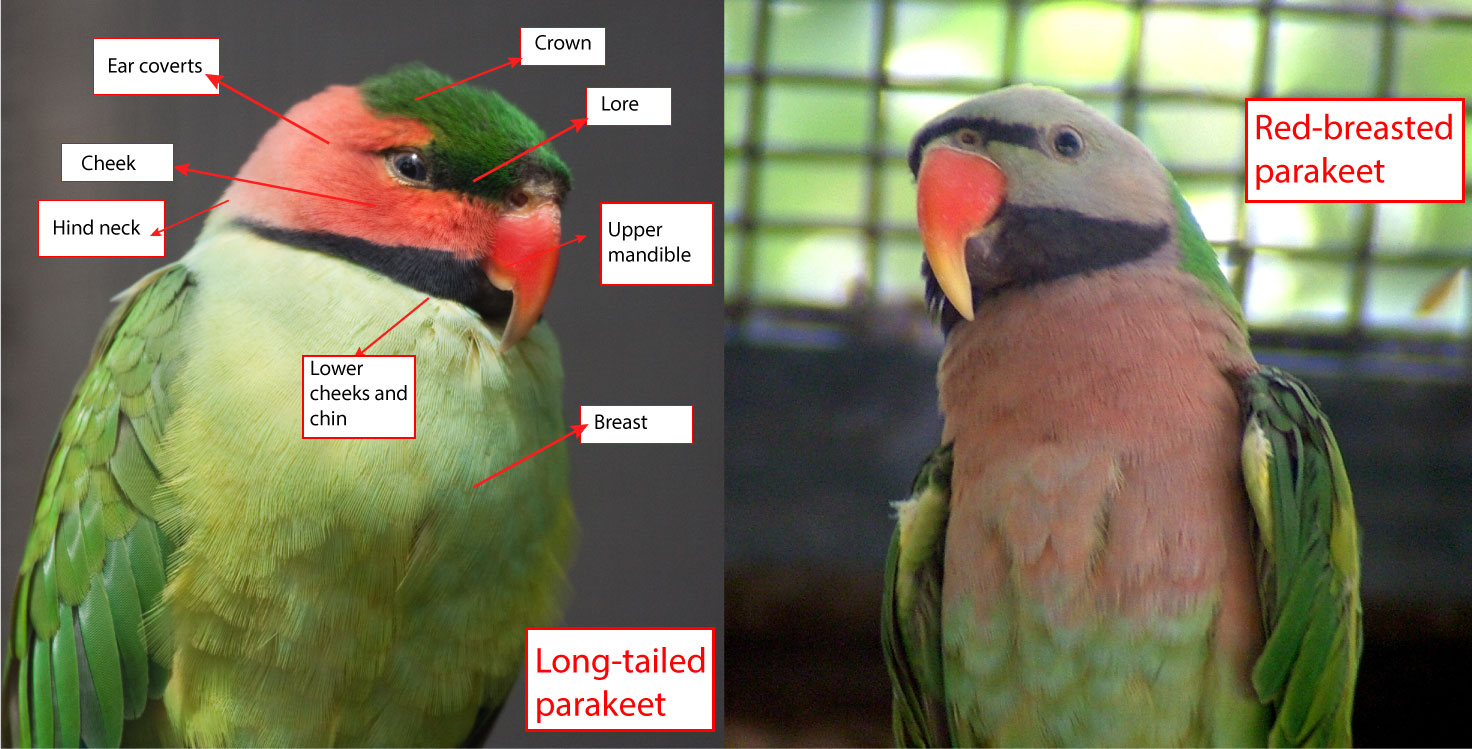 |
| Figure 15: Comparison of male long-tailed parakeet and male red-breasted parakeet. Both have red upper mandibles, black lores, and black lower cheeks, but may be distinguished by the colouring of the breast, cheeks and crown. The crown and the cheeks of the red-breasted parakeet are grey, while the crown and cheeks of the long-tailed parakeet are dark green and red respectively. The red-breasted parakeet has a red breast while the long-tailed parakeet does not. Diagram adapted from photo by Nathan Rupert, taken on 24th April 2011, in Western San Diego, California (left image), and Wikimedia Commons (right image). Available for use under Creative Commons Attribution-NonCommercial-ShareAlike 3.0. |
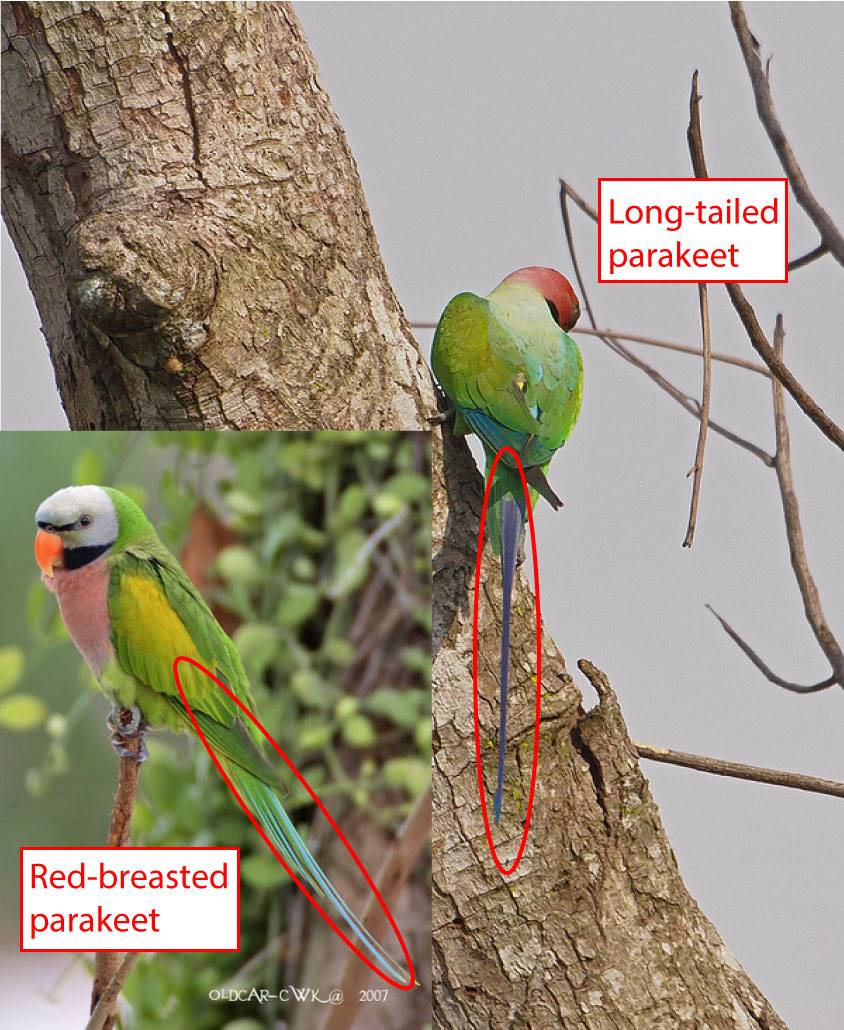 |
Figure 16: Both the male red-breasted parakeet and the long-tailed parakeets have a long blue tail, but the male red-breasted parakeet's tail may be shorter and of a lighter blue. Photo of red-breasted parakeet by Jonathan Cheah Weng Kwong (left image). Photo of long-tailed parakeet by Chong BT, in Kuala Langat, Malaysia, 2012 (right image). |
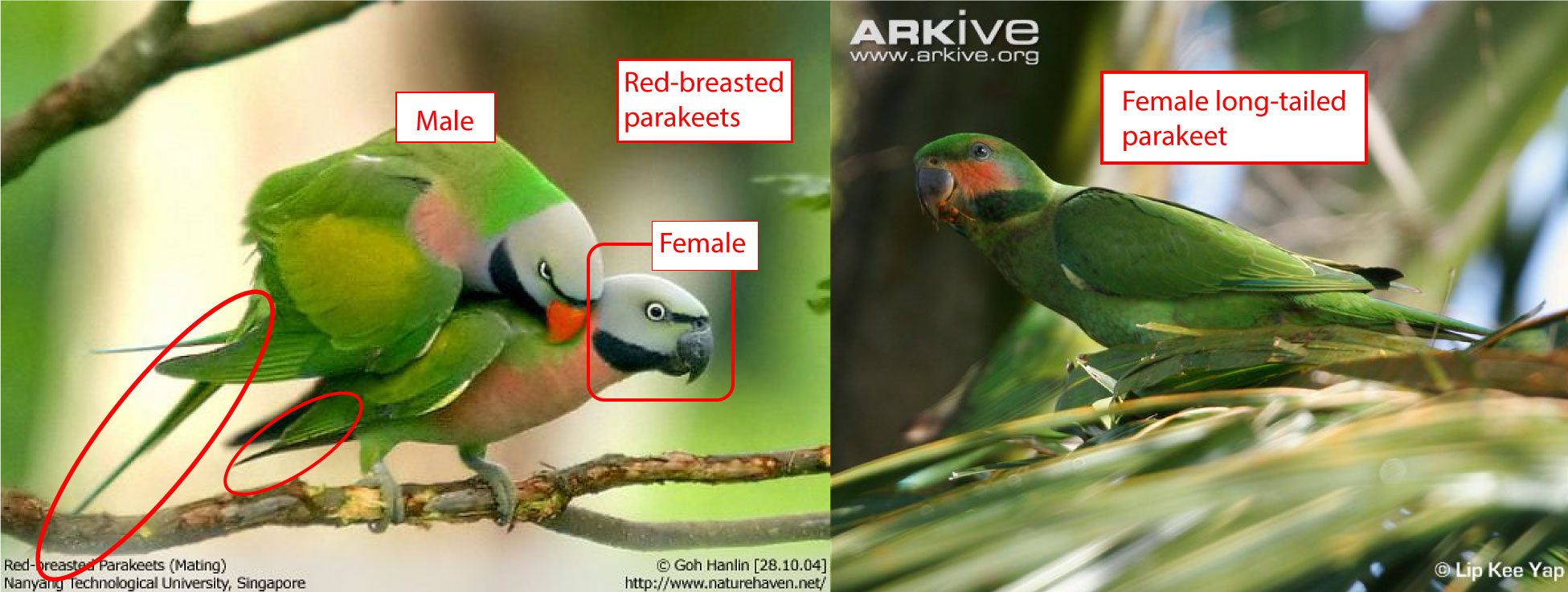 |
| Figure 17: The female red-breasted parakeet may be distinguished from the female long-tailed parakeet in the same manner as the male (Figure 15). The female red-breasted parakeet has a shorter tail and black mandibles compared to the male red-breasted parakeet. The female long-tailed parakeet has a shorter tail as well. Photo of red-breasted parakeets by Goh Hanlin. Photo of long-tailed parakeet by Lip Kee Yap. |
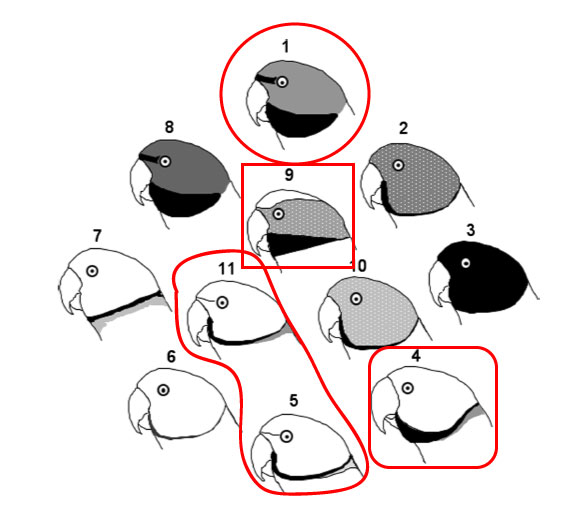 |
| Figure 18: Diagrammatic representation of three male Psittacula head plumage characters: (i) black, or coloured neck ring; (ii) thickening of the ventral portion of the neck ring to form a moustache plumage pattern; (iii) distinct colouration of the head plumage above the neck ring that differs from the plumage of the rest of the body (the darker the shading, the higher the contrast in head plumage to the body plumage). Non-shaded head regions indicate that head plumage is the same colour as rest of body (which is generally green-grey). Different shades refer to a colour continuum from dark grey through blue [full shading] to red [stipled shading] as follows, dark grey [slaty-headed-3] through dark blue [derbyan-8], pale blue [moustached-1], pale red [blossom-headed-10], red [longtailed-9], to dark red [plum-headed-2]). Legend: (1) red-breasted; (2) plum-headed; (3) slatyheaded; (4) alexandrine; (5) African ringneck; (6) echo; (7) Malabar; (8) derbyan; (inner circle) (9) longtailed; (10) blossom-headed; and (11) Indian ringneck. (5) and (11) are subspecies of the rose-ringed parakeet. Figure and caption adapted from Groombridge et al. (2004). |
Type Information
A type specimen refers to a specimen or a group of specimens that has a binomial species name attached to it.Psittacula longicauda has 3 holotypes.
The lectotype for Psittacula longicauda is stored in the Muséum national d'Histoire Naturelle de Paris (MNHN ZO MO-2004-81).
The type locality for Psittacula longicauda is Malacca, Malaysia.
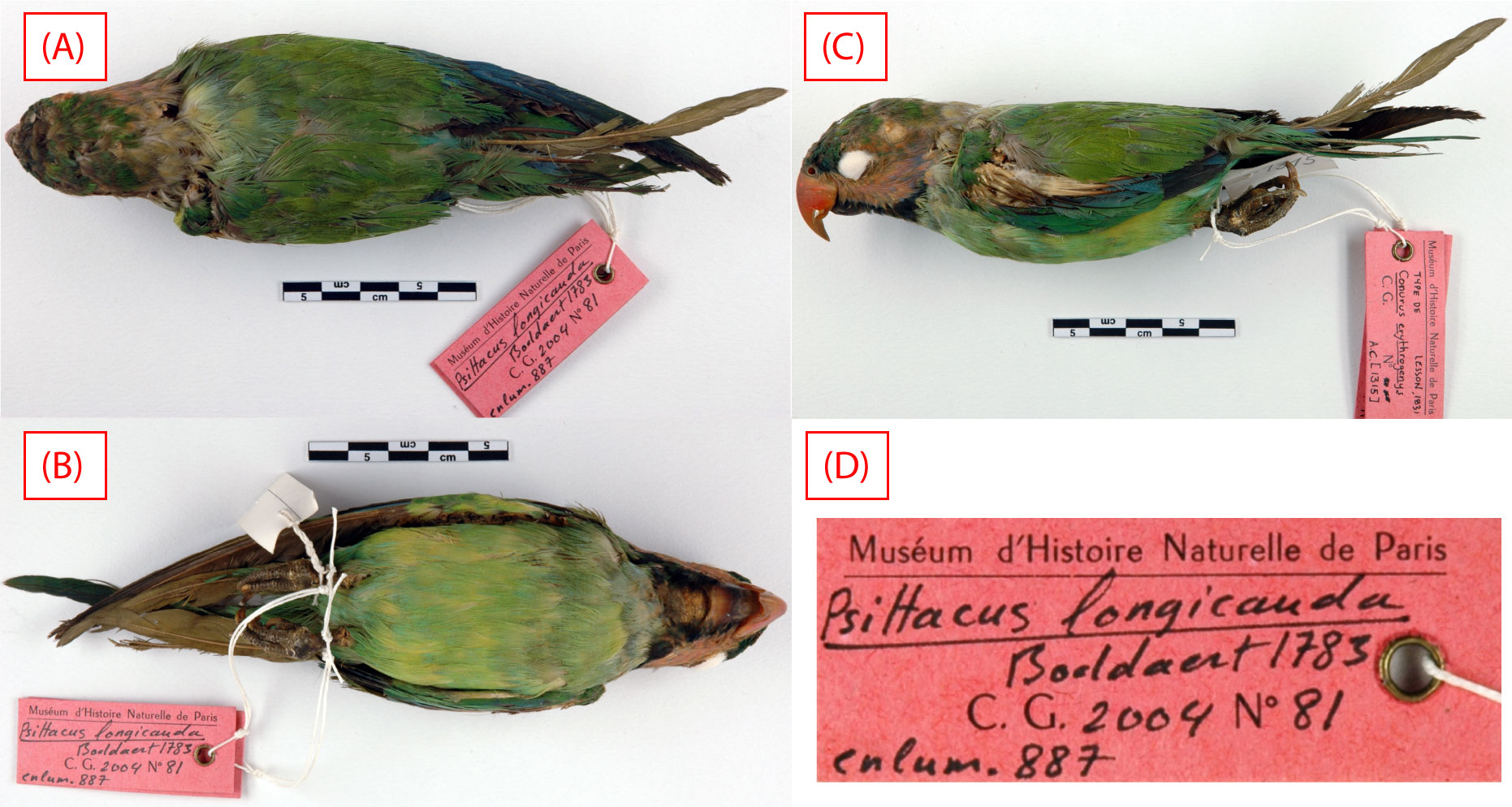 |
| Figure 19: Type specimen, first described as Psittacus longicauda by Boddaert in 1783. (A) Dorsal view (B) Ventral view (C) Side view (D) Label tag showing Museum in which type specimen is kept, author of species name, coordinates and the plate in the identification key by Boddaert (1783). Adapted from photos from GBIF. Available for use under Creative Commons Attribution 4.0 International Public License. |
Literature Cited
Boddaert, P. (1783). Table des planches enluminéez d'histoire naturelle de M. D'Aubenton : avec les denominations de M.M. de Buffon, Brisson, Edwards, Linnaeus et Latham, precedé d'une notice des principaux ouvrages zoologiques enluminés. 58 pp. + table, Utrecht.
Brown, R.W. (1956). The Composition of Scientific Words. Washington, D.C.: Smithsonian Institution Press.
Buffon, G.L.L. (1780) Histoire naturelle des oiseaux. De l’imprimerie royale, Paris, 1-558 pp.
Buffon, G. (2010). Contents. In W. Smellie (Ed.), The Natural History of Birds: From the French of the Count de Buffon; Illustrated with Engravings, and a Preface, Notes, and Additions, by the Translator (Cambridge Library Collection - Zoology, pp. V-Xv). Cambridge: Cambridge University Press.
Castelletta, M., Thiollay, J.M., & Sodhi, N.S. (2005). The effects of extreme forest fragmentation on the bird community of Singapore Island. Biological conservation, 121(1), 135-155.
Chng, S.C., & Eaton, J.A. (2016). Snapshot of an on-going trade: an inventory of birds for sale in Chatuchak weekend market, Bangkok, Thailand. Birding Asia, 25, 24-29.
Groombridge, J.J., Jones, C.G., Nichols, R. A., Carlton, M., & Bruford, M.W. (2004). Molecular phylogeny and morphological change in the Psittacula parakeets. Molecular phylogenetics and evolution, 31(1), 96-108.
Iqbal, M. (2015). Looking at online bird trading in Indonesia; a case study from South Sumatra. Birding Asia, 24, 132-135.
Neo, M.L. (2012). A review of three alien parrots in Singapore. Nature in Singapore, 5, 241-248.
Parr, M., & Juniper, T. (2010). Parrots: a guide to parrots of the world. Bloomsbury Publishing.
Shepherd, C.R. (2006). The bird trade in Medan, North Sumatra: an overview. Birding Asia, 5, 16-24.
Shimodaira, H., & Hasegawa, M. (1999). Multiple comparisons of log-likelihoods with applications to phylogenetic inference. Molecular biology and evolution, 16(8), 1114-1114.
Sodhi, N.S. (2002). The effects of food-supply on Southeast Asian forest birds. Ornithological Science, 1(1), 89-93.
Suárez-Díaz, E., & Anaya-Muñoz, V. H. (2008). History, objectivity, and the construction of molecular phylogenies. Studies in History and Philosophy of Science Part C: Studies in History and Philosophy of Biological and Biomedical Sciences, 39(4), 451-468.
Multimedia references
Website ReferencesAgri-Food & Veterinary Authority of Singapore. (2017). Ava.gov.sg. Retrieved 2 December 2017, from https://www.ava.gov.sg/docs/default-source/tools-and-resources/resources-for-businesses/factsheet_import_doc803f461875296bf09fdaff00009b1e7c.pdf?sfvrsn=2
BirdLife International. (2016). Psittacula longicauda. The IUCN Red List of Threatened Species 2016: e.T22685513A93077134. Retrieved 19 October 2017, from http://dx.doi.org/10.2305/IUCN.UK.2016-3.RLTS.T22685513A93077134.en.
Faheem, M. (2017). Long-tailed parakeet. Indianbirds.thedynamicnature.com. Retrieved 1 December 2017, from http://indianbirds.thedynamicnature.com/2017/03/long-tailed-parakeet-psittacula-longicauda.html
HBW Alive. (2017). Long-tailed Parakeet (Psittacula longicauda) videos, photos and sound recordings | the Internet Bird Collection. Hbw.com. Retrieved 2 December 2017, from https://www.hbw.com/ibc/species/long-tailed-parakeet-psittacula-longicauda
Integrated Taxonomic Information System. (n.d.). ITIS Standard Report Page: Psittacula longicauda. Itis.gov. Retrieved 3 December 2017, from https://www.itis.gov/servlet/SingleRpt/SingleRpt?search_topic=TSN&search_value=177651#null
Low, A., & OwYong, A. (2015). 5th Parrot Count- Final Report. Singapore Bird Group. Retrieved 2 December 2017, fromhttps://singaporebirdgroup.wordpress.com/2015/04/11/5th-annual-parrot-count-2015/
Low, A., & OwYong, A. (2016). 6th Parrot Count- Final Report. Singapore Bird Group. Retrieved 2 December 2017, from https://singaporebirdgroup.wordpress.com/2016/04/23/6th-parrot-count-final-report/
Low, A., & OwYong, A. (2017). 7th Parrot Count- Final Report. Singapore Bird Group. Retrieved 2 December 2017, from https://singaporebirdgroup.wordpress.com/2017/04/25/7th-parrot-count-2017/
National Geographic. (2016). Inside the Secret Trade That Threatens Rare Birds. News.nationalgeographic.com. Retrieved 2 December 2017, from https://news.nationalgeographic.com/2016/04/160419-bird-trade-african-grey-parrots-singapore-alex-the-parrot-cites/
Singapore Birds. (2017). Parrots. Singaporebirds.blogspot.sg. Retrieved 2 December 2017, from http://singaporebirds.blogspot.sg/2012/06/parrots.html
The Birds of NUS. (2012). Long-tailed Parakeet. Nusavifauna.wordpress.com. Retrieved 2 December 2017, from https://nusavifauna.wordpress.com/2012/07/29/long-tailed-parakeet/
Audio References
Audio 1: Yong, D.L. (2014, January 14). XC164588. Retrieved 14 November 2017, from www.xeno-canto.org/164588.
Audio 2: Cannizzaro, E. (Bornean Bird Conservation). (2011, March 25). XC94111. Retrieved 14 November 2017, from www.xeno-canto.org/94111.
Audio 3: Silva e Silva, R. (2014, December 29). XC209349. Retrieved 14 November 2017, from www.xeno-canto.org/209349.
Video References
Video 1: 13seaeagle. (2012, December 23). Long-Tailed Parakeet-Singapore [Video file]. Retrieved 3 December 2017, from https://www.youtube.com/watch?v=MeR22ZeNDko&feature=youtu.be
Video 2: LizMing Birds. (2016, May 14). Long-Tailed Parakeet (eating Starfruit) [Video file]. Retrieved 3 December 2017, from https://www.youtube.com/watch?v=nvPacpJFzA4&feature=youtu.be
Video 3: Yc Wee. (2015, June 21). Long-tailed parakeet eating female flowers of Alexandra Palm [Video file]. Retrieved 3 December 2017, from https://www.youtube.com/watch?v=kuudM9irlRU
Video 4: 13seaeagle. (2012, November 7). Long Tailed Parakeet Couple copulating @ Neo Tiew Lane 2 - Singapore [Video file]. Retrieved 3 December 2017, from https://www.youtube.com/watch?v=9mCmV_pph3A&feature=youtu.be
Image References
Figure 1: Rupert, N. (Photographer). (2011, April 24). Long-tailed parakeet. [digital image]. Retrieved 19 October 2017, from https://www.flickr.com/photos/nathaninsandiego/5662795489/in/photostream/
Figure 2: Low, A., & OwYong, A. (2015). 5th Parrot Count- Final Report. Singapore Bird Group. Retrieved 2 December 2017, from https://singaporebirdgroup.wordpress.com/2015/04/11/5th-annual-parrot-count-2015/
Figure 3: Boddaert, P. (1783). Table des planches enluminéez d'histoire naturelle de M. D'Aubenton : avec les denominations de M.M. de Buffon, Brisson, Edwards, Linnaeus et Latham, precedé d'une notice des principaux ouvrages zoologiques enluminés. 58 pp. + table, Utrecht. doi: 10.5962/bhl.title.39835 BHL Retrieved 30th November 2017, from https://www.biodiversitylibrary.org/item/109420#page/181/mode/1up
Figure 4: Adapted from Rupert, N. (Photographer). (2011, April 24). Long-tailed parakeet. [digital image]. Retrieved 19 October 2017, from https://www.flickr.com/photos/nathaninsandiego/5662795489/in/photostream/
Figure 5: Adapted from Chong, B.T. (Photographer). (2012). [digital image]. Retrieved 19 October 2017, from http://www.photomalaysia.com/forums/forum/showcase/birds/190964-long-tailed-parakeet-from-kuala-langat
Figure 6: Adapted from 2 images (1) Chong, B.T. (Photographer). (2012). [digital image]. Retrieved 19 October 2017, from http://www.photomalaysia.com/forums/forum/showcase/birds/190964-long-tailed-parakeet-from-kuala-langat (2) Susanne. (2014, January 12). [digital image]. Retrieved 30 November 2017, from http://www.successwithparrots.com/amazing-parrot-feet/
Figure 7: Adapted from 2 images: (1) Goh, H. (n.d.). Male and female long-tailed parakeets perched. [digital image]. Retrieved 19 October 2017, from http://www.arkive.org/long-tailed-parakeet/psittacula-longicauda/image-G49251.html (2) Baker, N. (n.d.). [digital image]. Retrieved 19 October 2017, from http://www.ecologyasia.com/verts/birds/parakeets.htm
Figure 8: Chong, B.T. (Photographer). (2012). [digital image]. Retrieved 19 October 2017, from http://www.photomalaysia.com/forums/forum/showcase/birds/190964-long-tailed-parakeet-from-kuala-langat
Figure 9: Adapted from 3 images: (1) Chong, B.T. (Photographer). (2012). [digital image]. Retrieved 19 October 2017, from http://www.photomalaysia.com/forums/forum/showcase/birds/190964-long-tailed-parakeet-from-kuala-langat (2) Chong, B.T. (Photographer). (2012). [digital image]. Retrieved 19 October 2017, from http://www.photomalaysia.com/forums/forum/showcase/birds/190964-long-tailed-parakeet-from-kuala-langat (3) Poh, L. (2003). [digital image]. Retrieved 19 October 2017, from http://orientalbirdimages.org/search.php?Bird_ID=519&Bird_Image_ID=3899
Figure 10: BirdLife International. (2016). Psittacula longicauda. The IUCN Red List of Threatened Species 2016: e.T22685513A93077134. Retrieved 19 October 2017, from http://dx.doi.org/10.2305/IUCN.UK.2016-3.RLTS.T22685513A93077134.en.
Figure 11: Adapted from Parr, M., & Juniper, T. (2010). Parrots: a guide to parrots of the world. Bloomsbury Publishing. Retrieved 19 October 2017, from https://books.google.com.sg/books?hl=en&lr=&id=2sCkAwAAQBAJ&oi=fnd&pg=PP1&dq=Parrots:+A+Guide+to+Parrots+of+the+World&ots=qEyhCOFhOT&sig=VcUU7KSplFjrpgfZMjE4-QnS6d8#v=onepage&q&f=false
Figure 12: Adapted from Groombridge, J. J., Jones, C. G., Nichols, R. A., Carlton, M., & Bruford, M. W. (2004). Molecular phylogeny and morphological change in the Psittacula parakeets. Molecular phylogenetics and evolution, 31(1), 96-108.
Figure 13: Adapted from Groombridge, J. J., Jones, C. G., Nichols, R. A., Carlton, M., & Bruford, M. W. (2004). Molecular phylogeny and morphological change in the Psittacula parakeets. Molecular phylogenetics and evolution, 31(1), 96-108.
Figure 14: Adapted from Groombridge, J. J., Jones, C. G., Nichols, R. A., Carlton, M., & Bruford, M. W. (2004). Molecular phylogeny and morphological change in the Psittacula parakeets. Molecular phylogenetics and evolution, 31(1), 96-108.
Figure 15: Adapted from 2 images: (1) Rupert, N. (Photographer). (2011, April 24). Long-tailed parakeet. [digital image]. Retrieved 19 October 2017, from https://www.flickr.com/photos/nathaninsandiego/5662795489/in/photostream/ (2) SuperJew. (2006, July 12). Psittacula alexandri. [digital mage]. Retrieved 3rd December 2017, from https://commons.wikimedia.org/wiki/File:Psittacula_alexandri_-Jerusalem_Biblical_Zoo-4-3c.jpg#filelinks
Figure 16: Adapted from 2 images: (1) Cheah, J.C.W. (Photographer). (2007, February 6).Red-breasted parakeet. [digital image]. Retrieved 19 October 2017,from http://orientalbirdimages.org/search.php?Bird_ID=517&Bird_Image_ID=24710 (2) Chong, B.T. (Photographer). (2012). [digital image]. Retrieved 19 October 2017, from http://www.photomalaysia.com/forums/forum/showcase/birds/190964-long-tailed-parakeet-from-kuala-langat
Figure 17: Adapted from 2 images: (1) Goh, H. (Photographer). (2004, October 28). Red-breasted parakeets (Mating). [digital image]. Retrieved 19 October 2017, from http://orientalbirdimages.org/search.php?Bird_ID=517&Bird_Image_ID=10765&p=94 (2) Yap, L.K. (Photographer). (n.d.). [digital image]. Retrieved 19 October 2017, from http://www.arkive.org/long-tailed-parakeet/psittacula-longicauda/image-G45595.html
Figure 18: Adapted from Groombridge, J. J., Jones, C. G., Nichols, R. A., Carlton, M., & Bruford, M. W. (2004). Molecular phylogeny and morphological change in the Psittacula parakeets. Molecular phylogenetics and evolution, 31(1), 96-108.
Figure 19: Adapted from 4 images from GBIF, author unknown (n.d.). Retrieved 3 December 2017, from https://www.gbif.org/occurrence/1019444573
Additional images:
Figure 1: Adapted from 2 images: (English translation): Buffon, G. (2010). Contents. In W. Smellie (Ed.), The Natural History of Birds: From the French of the Count de Buffon; Illustrated with Engravings, and a Preface, Notes, and Additions, by the Translator (Cambridge Library Collection - Zoology, pp. V-Xv). Cambridge: Cambridge University Press. Retrieved 17 November 2017, from https://www-cambridge-org.libproxy1.nus.edu.sg/core/services/aop-cambridge-core/content/view/9CA419B7A1CFF17E9B27EA8C0055C285/9780511782602c_p1-585_CBO.pdf/natural_history_of_birds.pdf (French translation): Boddaert, P. (1783). Table des planches enluminéez d'histoire naturelle de M. D'Aubenton : avec les denominations de M.M. de Buffon, Brisson, Edwards, Linnaeus et Latham, precedé d'une notice des principaux ouvrages zoologiques enluminés. 58 pp. + table, Utrecht. doi: 10.5962/bhl.title.39835 BHL Retrieved 17 November 2017, from https://www.biodiversitylibrary.org/item/109420#page/181/mode/1up
Figure 2: Obtained from zoonomen, author unknown (n.d.). Retrieved 19 October 2017, from http://www.zoonomen.net/cit/RI/SP/Psit/psit00110a.jpg
Figure 3: Ho, C. [digital image]. (2017, November 13).
Figure 4: Ho, C. [digital image]. (2017, November 13).
Figure 5: Ho, C. [digital image]. (2017, November 13).
Figure 6: Tan, D. (2015, November 21). [digital image]. Retrieved 18 October 2017, from https://www.instagram.com/p/-WKBsDwjYV/?taken-by=g33k5p34k
Figure 7: Lee, E.K.P. (n.d.). Juvenile long-tailed parakeet in nest hole. [digital image]. Retrieved 19 October 2017, from http://www.arkive.org/long-tailed-parakeet/psittacula-longicauda/image-G45611.html
Figure 8: Yap, L.K. (n.d.). Confrontation between male and female long-tailed parakeets. [digital image]. Retrieved 19 October 2017, from http://www.arkive.org/long-tailed-parakeet/psittacula-longicauda/image-G45596.html
Figure 9: Yap, L.K. (n.d.). Flock of parakeets queueing at feeding area. [digital image]. Retrieved 19 October 2017, from http://www.arkive.org/long-tailed-parakeet/psittacula-longicauda/image-G45598.html
Figure 10: KDS444. (2014, August 19). Diagram of a chicken's wing feathers. [digital image]. Retrieved 30 November 2017, from https://commons.wikimedia.org/wiki/File:Chicken_wing.svg
Figure 11: Screenshot. Retrieved 2 December 2017, from http://north-east-region.locanto.sg/ID_1084759562/SOLD-4-month-old-long-tailed-parrot-parakeet.html
Acknowledgements
I would like to thank the following:
David Tan, Department of Biological Sciences, National University of Singapore - for providing the juvenile specimen for photos, and his photo of an adult specimen
Wee Kin Guan, Assistant Librarian, Science Library, National University of Singapore - for help with finding the original description of the long-tailed parakeet
Links to other types of species pages
IUCN Red List. Long-tailed parakeet.//Psittacula longicauda// (Boddaert, 1783) in GBIF Secretariat (2017). GBIF Backbone Taxonomy. Checklist Dataset https://doi.org/10.15468/39omei accessed via GBIF.org on 2017-11-16.
Long-tailed parakeet. (2012). NUS Avifauna.
Parrot Encyclopedia
Additional Notes and Images
Original Description
Psittacula longicauda was first named by Pieter Boddaert in 1783, in an identification key titled Planches enluminées, which contains coloured plates of illustrations and provides Linnaean scientific names of the species described in Buffon’s book Histoire Naturelle, published in 1780.
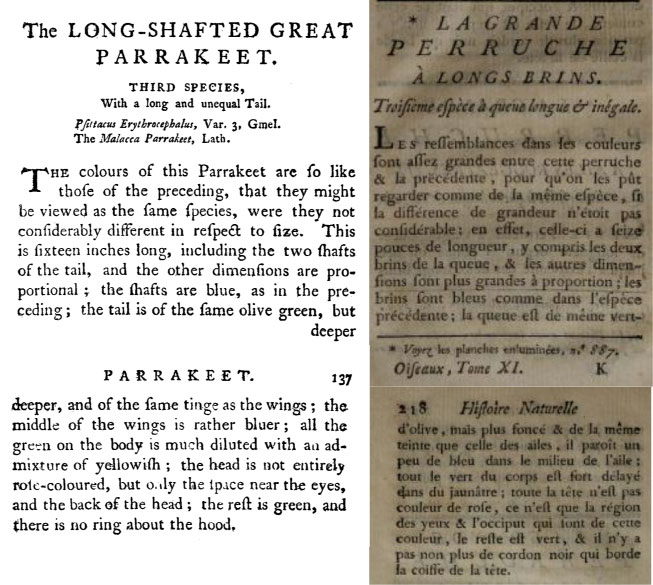 |
| Figure 1: The original description by Buffon (1780) in French on the right of the image, and in English on the left of the image (named the long-shafted great parrakeet in a 1793 translation by William Snellie (Buffon, 2010). Original description English translation |
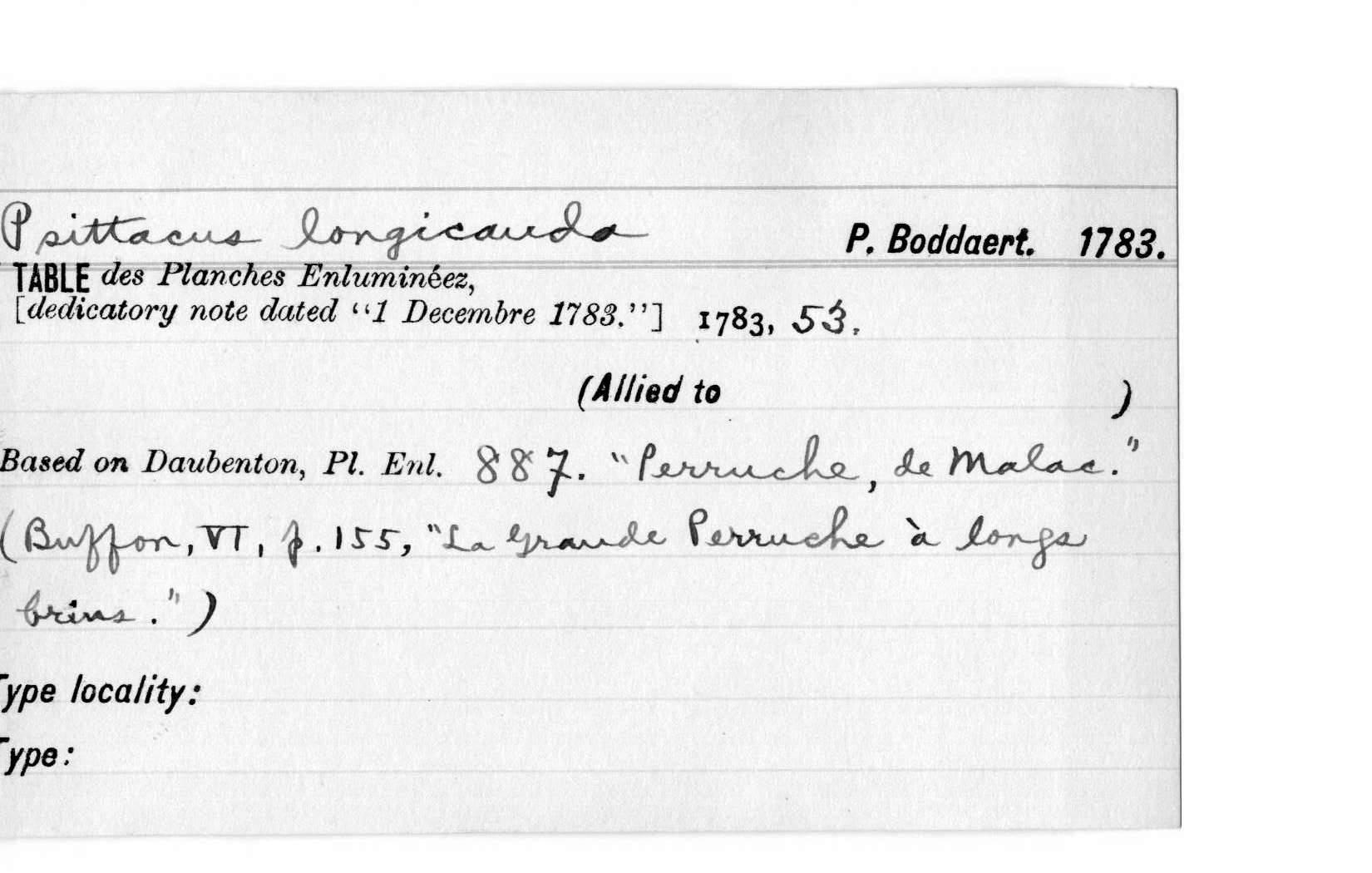 |
| Figure 2: A record of Psittacula longicauda as Psittacus longicauda. Image from zoonomen. |
Juvenile specimen
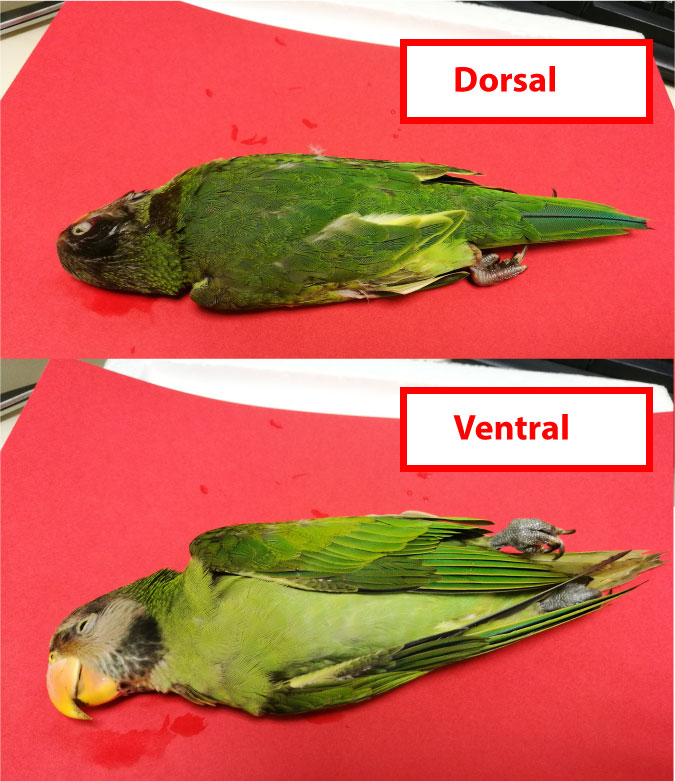 |
| Figure 3: Dorsal and ventral view of a juvenile long-tailed parakeet. Specimen collected by Ananthanarayanan Sankar, on the 8th March 2017. The tail is short relative to the overall body length, with a hint of blue. Photo by Crystal Ho, 2017. |
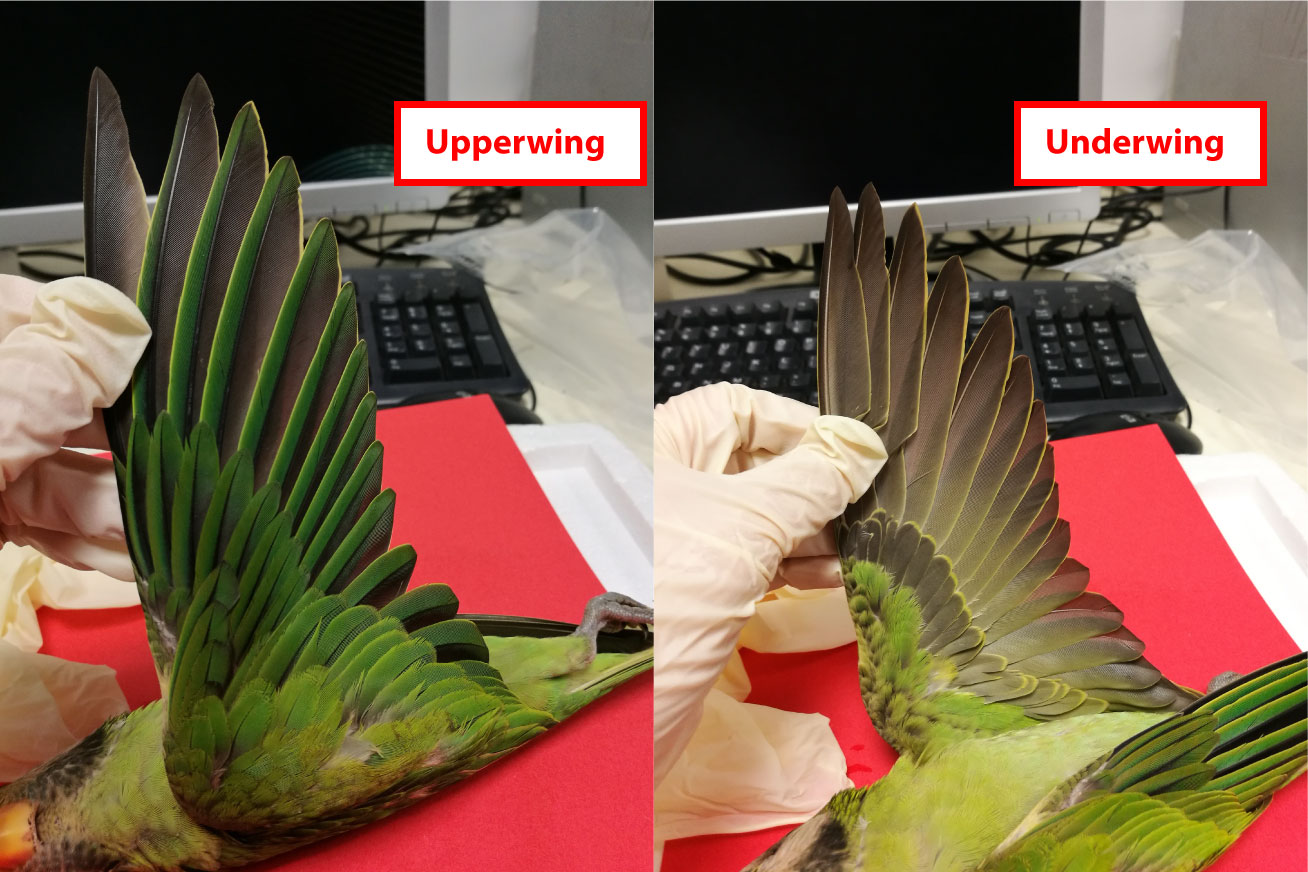 |
| Figure 4: Upperwing: primary, outer and secondary coverts of a juvenile long-tailed parakeet, lacking blue and has not undergone the full moult to adult blue outer primary and secondary feathers (pers. comm. David Tan). Light yellow undercoverts on the underwing. Specimen collected by Ananthanarayanan Sankar, on the 8th March 2017. Photo by Crystal Ho, 2017. |
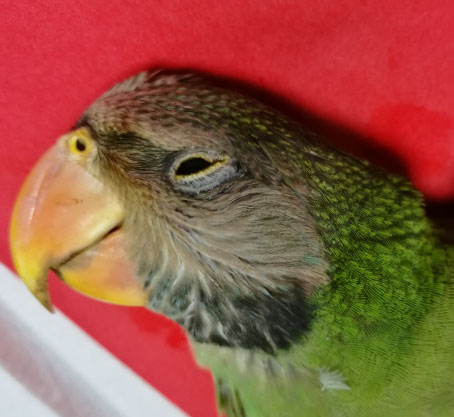 |
| Figure 5: Head of juvenile long-tailed parakeet. The beak colour has yet to change to a brighter salmon pink-red or brown. The cheeks are a faint pink. Specimen collected by Ananthanarayanan Sankar, on the 8th March 2017. Photo by Crystal Ho, 2017 |
Adult specimen
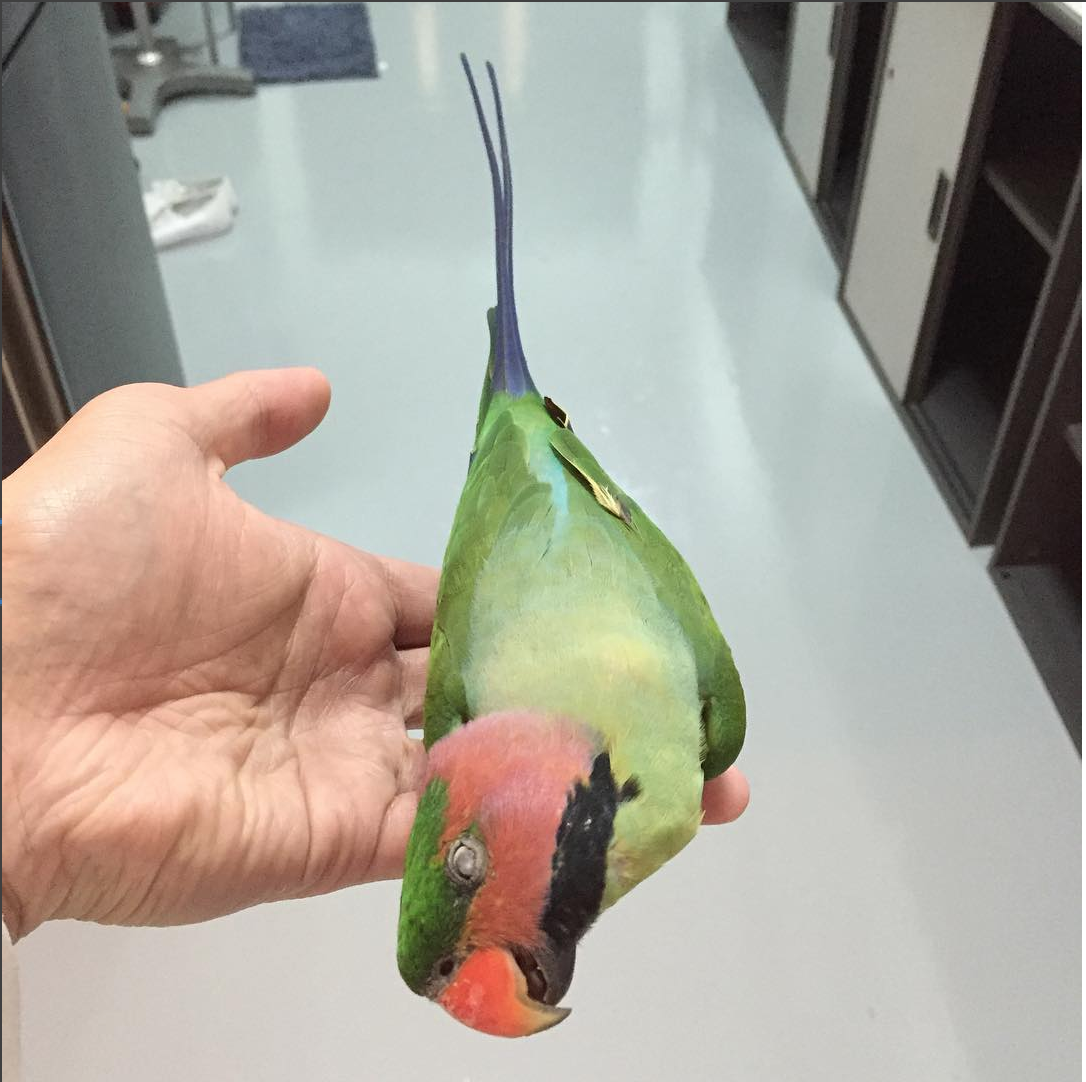 |
| Figure 6: Image of adult specimen taken by David Tan. |
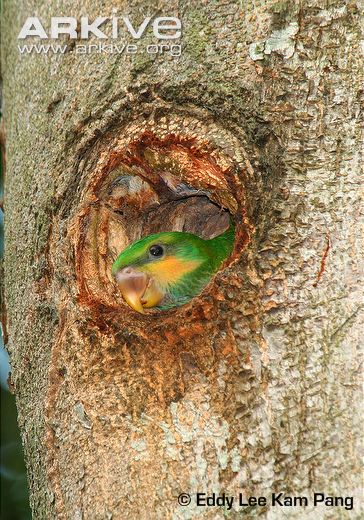 |
| Figure 7: Juvenile long-tailed parakeet in a nest hole in a tree. Photo by Eddy Lee Kam Pang. |
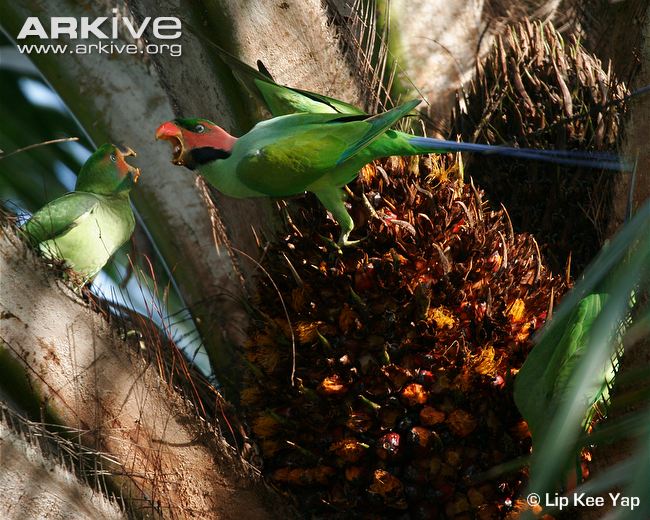 |
| Figure 8: Confrontation between female and male parakeets. Female is on the left; male is on the right. Photo by Lip Kee Yap. |
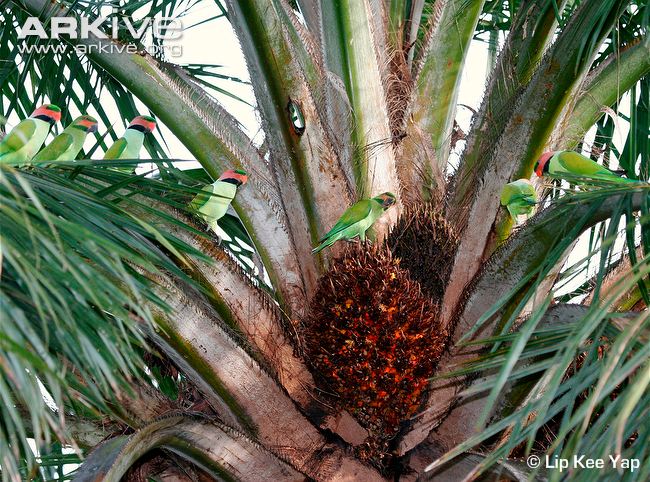 |
| Figure 9: Flock of parakeets. Plant unknown. Photo by Lip Kee Yap. |
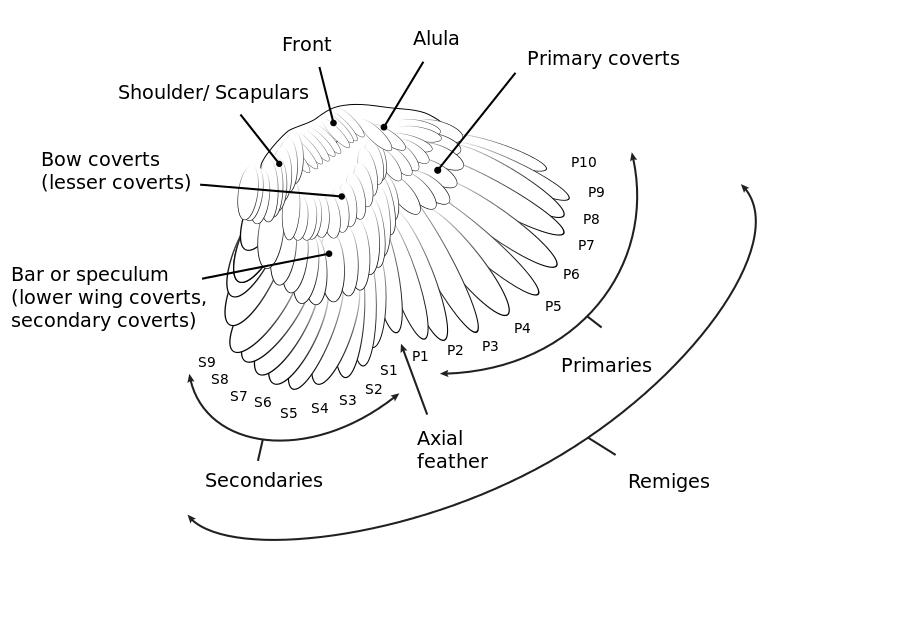 |
| Figure 10: Diagrammatic representation of wing feathers from Wikimedia Commons. Available for use under Creative Commons Attribution 4.0 International Public License. |
 |
| Figure 11: A juvenile long-tailed parakeet for sale online in Singapore. |
[Invalid Include: Page not found: ]